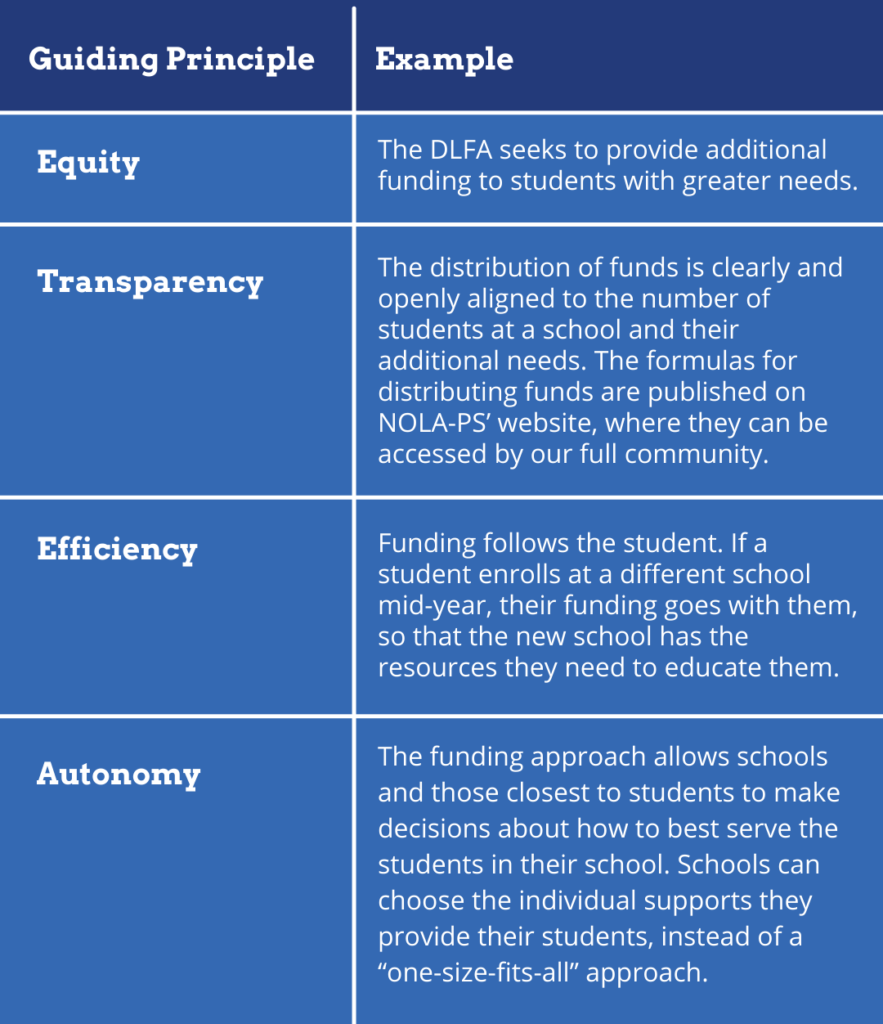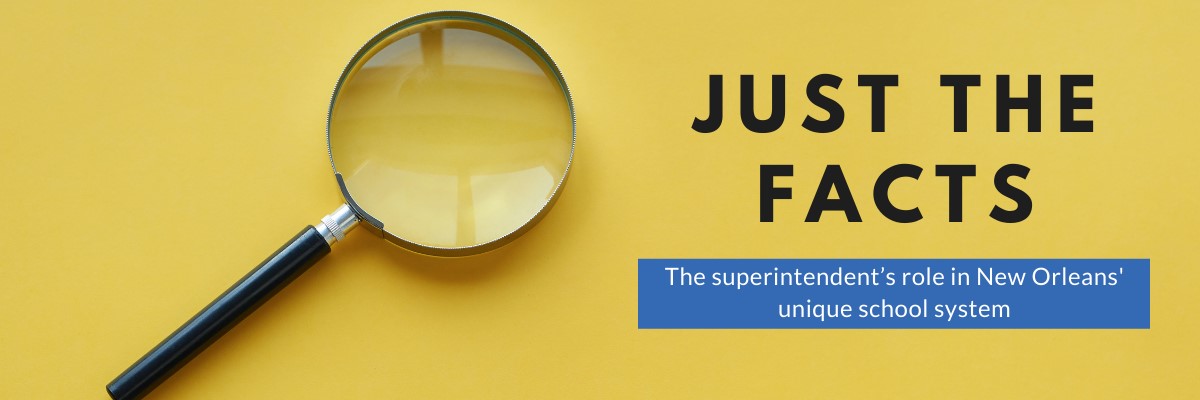As the Orleans Parish School Board (OPSB) continues its search for the next superintendent of NOLA Public Schools (NOLA-PS), NSNO’s “Just The Facts” series will cover what the superintendent’s role entails in our unique system of schools.
The Issue: School Funding
- In New Orleans, schools receive funding based on individual student needs. For example, schools receive more dollars for students with disabilities or students learning English.
- The total amount of money available for schools each year is limited, so to most equitably distribute these scarce resources, the district uses a process called the District Level Funding Allocation (DLFA).
- This type of distribution was first developed for Recovery School District schools in 2007, and in 2016, was expanded to all NOLA-PS schools.
- OPSB policy requires the NOLA-PS superintendent to review the DLFA every few years in collaboration with schools and education stakeholders.
- The superintendent’s latest DLFA plan, which will take effect in July 2022, will continue to equitably allocate funds towards students with the greatest needs in our system.
The System
New Orleans’ system of schools is different than many. When it comes to budget, three aspects stand out:
- Choice: New Orleans’ system allows students and families to choose the public school that best fits their needs, no matter where they live.
- Diverse Options: This means schools can vary widely in structure and approach, which may draw students with different needs and interests to different schools.
- School-based budgets: Unlike a traditional system in which a central office manages the budget, schools in New Orleans independently budget for, spend, and report on how they spent money to educate students.
How do these differences affect how we allocate funds across schools?
Each year, the school district allocates a limited amount of state and local revenues across schools. In New Orleans, this process is called the district level funding allocation (DLFA). While all schools receive “baseline” funding through the DLFA based on the number of students they teach, some schools enroll more students with additional needs who require more resources–students who need speech therapy, for example, or students learning English for the first time. Through the DLFA, their schools get extra funding in addition to their “baseline” funding. Many large cities use this approach, but to our knowledge, New Orleans is the only system in Louisiana using it.
What areas of student needs receive additional funding via the DLFA?
- Students with Disabilities
- English Learners
- Gifted & Talented
- Career & Technical Education (CTE)
- Students who are “over age” by 2 or more years for their grade
- Students who have been expelled in the past
- Students who have been incarcerated
Generally, “baseline” funding for all students accounts for 80% of the school system budget, and 20% goes to covering additional needs for each student counted in the categories above.
How has the DLFA changed over time?
The DLFA has been in place for all New Orleans public schools citywide since 2016, when schools were unified under the Orleans Parish School Board (OPSB). The DLFA was originally based on a formula developed by the Recovery School District. Over time, there have been small changes, and additional categories have been added.
The Superintendent’s Role in Funding Schools
State legislation (Act 91) requires the local school board (OPSB) to ensure funds are allocated to schools based on students’ characteristics or needs. To do this, OPSB developed Policy DCBA, which requires the NOLA-PS Superintendent to develop standard rules related to the amount of funding provided across different categories of student needs, agreed upon through engagement with school leaders. The policy also requires the Superintendent to review these rules every two years, updating them if necessary.
How were changes to the DLFA made this year?
- Input from educators, experts, and the community: This year, NOLA-PS partnered with NSNO to engage with school leaders, school finance directors, groups that provide services for students with special needs, and charter board leaders to review the current DLFA and propose changes.
- School Finance Working Group: Ten school finance directors volunteered to participate in a School Finance Working Group alongside representatives from NOLA-PS, NSNO, and the Louisiana Association of Public Charter Schools (LAPCS). The group met eight times over five months and reviewed detailed data and proposals to modify the existing DLFA. Throughout this process, the group sought and integrated feedback from the broader education community. The group also developed a document, The New Orleans Public Schools Funding Guidebook, which outlines how our system of schools receives and spends public education funding. This document is being finalized and will be shared publicly this spring.
- Guiding principles: The working group agreed with the current DLFA and articulated guiding principles of Equity, Transparency, Efficiency, and Autonomy to anchor the DLFA going forward.

- Final approval: The working group’s final recommendations were adopted by the Superintendent and presented to OPSB for the next two school years.
What new DLFA changes will be in effect for the next two school years (2022 – 2023 and 2023 – 2024)?
Funding for the 2022-2024 school years will keep the same categories for the DLFA (such as English Learners and Students With Disabilities,) with additional shifts, including:
- Certain specialized citywide programs, like the Travis Hill Schools and the Center for Resilience, are funded separately from other schools. Part of their funding is provided from the “Systemwide Needs Program Fund (SWNP),” the budget for which is set in the spring. This year’s working group determined that if the available SWNP funding is short of what these programs need, they can fill the gap with some of the funding from the DLFA that schools receive.
- Importantly, if this does occur, the proportion of funding each school receives through the DLFA remains the same, though the overall amount would decrease slightly. This is a one-time shift and would require the school board to submit a revised budget for the SWNP for the coming school year (2022 – 2023).
- In recent years, some local revenues were distributed to schools separately from the rest of state and local funding in the DLFA. Instead of being differentiated for students’ needs, it was distributed on a flat, per pupil basis. In order to increase equity, these funds–an estimated $18 million in 2022-2023–will be treated like all other revenues, significantly increasing the amount of funds that can be differentiated according to student needs.
Continued Collaboration
NOLA-PS and the superintendent have shared that they will be in close contact with schools around their experience with this funding formula. Our new superintendent will carry this task forward, and, in the years ahead, they will be called to help set the DLFA again in alignment with their guiding principles. They will continue to collaborate with schools in order to ensure that funding is aligned to schools’ and students’ needs. NOLA-PS committed to routine analyses of each year’s implementation of the DLFA, and also committed to exploring specific analyses about potential changes in schools’ costs related to special education, such as costs for specialized transportation and programs. Going forward, schools and the district will likely have to contend with the impact of declining student enrollment and COVID-19 on revenues and school operation costs.
Managing student funding is always a difficult process, but New Orleans’ funding formula means that equity comes first. Each of our students is different, and we are able to provide schools with resources tailored to their individual needs.
